SURF held the initial event of its Bridging Culture and Regeneration programme in Dundee, which became the UK’s first UNESCO City of Design in December 2014. What makes Dundee a globally recognised hub for creativity and innovation? How can other cities learn from its success? In this article, Gillian Easson, of the admired Creative Dundee network, outlines the city’s ongoing cultural development and suggests policy recommendation for better connecting creativity with place-based regeneration.
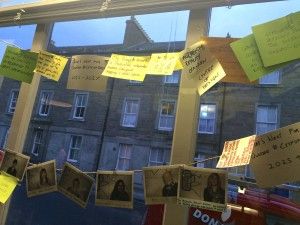
Dundee residents consider what it means to be a city of design at the Pop Up Design Cafe
Dundee, as you’ve no doubt heard of late, is a really exciting place to be right now. It feels like the city is collectively pulling together its rich cultural resources, and although we may all have slightly different ambitions for the city, our vision is shared to ensure all citizens thrive and culture is at the core.
As a creative network which amplifies and connects Dundee’s creative scene, public engagement and understanding the needs of the city and its citizens have always been at the heart of Creative Dundee’s work.
Collective creative action
Since starting Creative Dundee as a side project blog in 2008, before any of the city’s current regeneration plans were on the cards, to constituting it as a social venture in 2013, we have offered an equitable platform for creatives to be seen and heard by, and to connect with, the rest of the city.
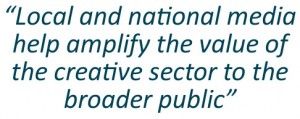 The motivation seven years ago was to profile a vibrant and strong sector that was then totally underrepresented. Today it’s a sector which is one of the main driving forces behind the redevelopment.
The motivation seven years ago was to profile a vibrant and strong sector that was then totally underrepresented. Today it’s a sector which is one of the main driving forces behind the redevelopment.
You only have to visit one of the city’s many creative collectives or artist-led spaces to get a sense of why we do what we do; such as GENERATOR Projects, Tin Roof, Fleet Collective, Wasps, Dundee Makerspace and Dundee Urban Orchard; they are just as critical to the city’s ecosystem as the large cultural organisations – we’ve attempted to chart this here.
Over the last couple of years, I’ve been involved in a number of the strategic cultural developments, including collaborating with other local creatives to develop We Dundee, a crowd-sourcing platform that engaged over 4000 people in the city’s future; and working with fellow cultural partners on our UNESCO City of Design recognition.
Increasingly, Creative Dundee is involved in the delivery of elements of the city’s new cultural and design strategy – which for a small, relatively new organisation is a great opportunity – whilst continuing to offer the critical direct support for local creatives. People think Creative Dundee is a much larger organisation, but I’m the only part-time employee; therefore, working in partnership with other organisations is critical. We’re grateful to Dundee City Council and Creative Scotland who currently part-support Creative Dundee, with additional income generated through trading.
Amplifying, showcasing, connecting
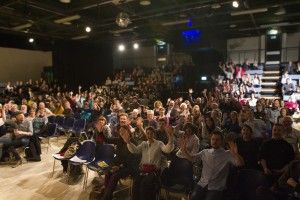
Pecha Kucha Night features highly among Creative Dundee’s most successful events
Our active online platform, which promotes creatives, opportunities and events, is our main focus. The events we run such as Pecha Kucha Night give local creatives, irrespective of the stage they are at in their career, the chance to present to, and inspire, a broad audience. We attract around 300 people each time, comprising a diverse mix of professionals and city enthusiasts from the creative, business, science, enterprise and public sector worlds.
Within these events, we’ve built in pop-up exhibition opportunities for creatives to show their work. Such chances can be difficult to find for those starting out, and we also commission different graphic designers and photographers for each event. This has proved to be an important way of spotting, commissioning and giving profile to local talent.
Working across traditionally siloed industry sectors is increasingly critical for innovation and progress. We’re addressing this in different ways. For example, The MIX IN is an event we’re working on in partnership with the Scotland Food and Drink Network, to bridge the food & drink and creative & digital sectors and encourage a sharing of expertise and ideas at an exciting and informal evening event.
We’ve also held pop-up design cafes, where we ask the public what being a city of design means to them, and arranged open calls to screen local films on a big screen in City Square for Screen in the Square, showcasing community groups through to professional film makers. Creative Dundee has featured in the national media, from the Independent to the Times, and local media have also been hugely supportive. This helps amplify the value of the creative sector to the broader public.
Working with similar creative networks in Scotland, including Creative Edinburgh and Creative Stirling, we are sharing ideas and building learning and capacity to help inform practice and policy. An independent review of the three creative city networks has been published. We are collaborating with Perth & Kinross Council to establish Perthshire Creates across a vast local authority area rich in contemporary creative talent to better profile this to locals and visitors.
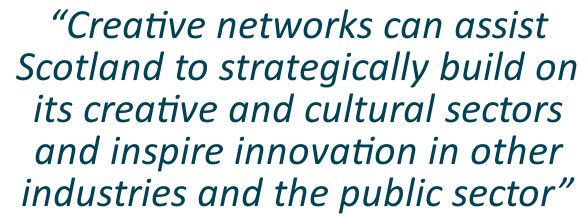
Bridging creative practice and policy
Despite these activities, we and other dynamic organisations of a similar size still have a tough time gaining the understanding, trust and support of national organisations. I believe the creative networks can assist Scotland to strategically build not only its creative and cultural sectors, but also inspire innovation in other industries and the public sector. This is something I’ll be devoting more time and attention to in future.
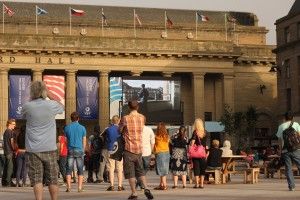
Screen in the Square provides local films with significant profile
Engaging creatives in place-based regeneration plans can be hugely valuable for all. Here are some brief thoughts on key areas that I feel can help ‘bridge’ local creative practice and policy:
- Encourage more flexible ways to procure services from local creatives to stimulate the trade and support development of local talent. This is something we have advocated for locally, which has been integrated into Dundee’s new Cultural Strategy.
- Bridging organisations are well-connected to what is happening on the ground. They understand both the practical needs across different disciplines within their sector, and how these complement and enhance national policy. They bridge gaps between strategy and action, and can bring innovation, experimentation and responsiveness as a result of their structure, style and scale. This flexibility allows them to work across disciplines, postcodes and silos.
- See our communities as partners, collaborators and equals, rather than recipients of services and support. In future a flatter, less hierarchal, cross-sectoral structure will be key to productive public engagement. A great article on the future of organisations by Julian Stodd articulates this point well.
- Articulate how creatives can fit into local regeneration initiatives. Creative industries extend well beyond artists and architects to, for example, designers and software developers. Some, such as cultural sector workers that meet citizens and visitors every day in our museums, galleries and heritage venues, don’t always get the chance to feed into place-based cultural development and tourism This should change.
Although primarily England-focused, the ‘Local Matters’ section of Warwick Commission’s recent Enriching Britain report offers interesting local policy recommendations for cultural regeneration. It stresses that:
“the role of cultural organisations as strategic partners in the more fundamental place-shaping role, building and moulding local communities and identities, remains underdeveloped”
I hope that similar thinking, and critically doing, is made a policy priority here in Scotland too. To integrate this thinking requires an openness on all sides; a culture of shared values, visions, ambitions, and an understanding of often polar opposite working styles. Cultural organisations of all shapes and sizes can play a significant role in bridging this activity, which is being demonstrated here in Dundee.
Dundee is not perfect. Like all cities, we have our own significant challenges. With a focus, however, on the needs of citizens, a culture of partnership working (beyond simply the big institutions working together), and a healthy attitude to experimentation, I believe we have all the ingredients for a truly sustainable, smart and creative city.
A short film on Creative Dundee is available on Vimeo:
